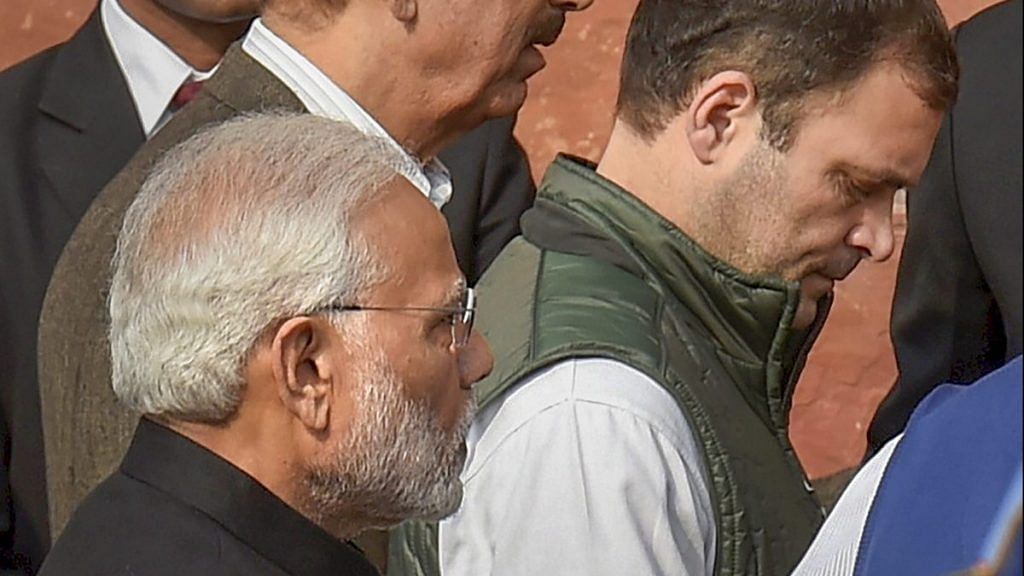Prime Minister Narendra Modi’s all-party meeting on the Ladakh stand-off with opposition leaders last week went more or less on predicted lines. While there was a show of solidarity at the meeting, a lot of muck has been thrown by the Bharatiya Janata Party and the Congress at each other since, be it in TV debates or through statements in the media. The political discourse in India cannot be allowed to descend to the level of one-upmanship between the country’s two major national parties. Saner elements in both camps will have to bury the hatchet and work as a team to forge a new strategy not only to tide over the current crisis but also to face possible challenges in the future, especially as China is unlikely to back down.
It is a great relief that India’s entire political establishment has so far spoken in one voice. Except when Communist Party of India (Marxist) general secretary Sitaram Yechury dug out the hackneyed Panchsheel and asked the Modi government to “strictly” follow it. Perhaps the CPI(M) should try to use its influence to give the Chinese leadership a few lessons on Panchsheel. The ‘five principles of peaceful coexistence’ that India and China signed in 1954, four years after the Chinese annexation of Tibet, is as irrelevant today as the Communist parties.
Adhering to the idea of Panchsheel unilaterally notwithstanding, 1962 dealt a severe blow to India’s image, strategy, soft power approach, and unwrapped the border issue with a new map. Three years later, we had a hostile China breathing down our neck and an aggressive Pakistan waging a war against us. But just six years after that, a strong and determined leadership under then-Prime Minister Indira Gandhi broke the back of Pakistan, consigned the ‘two-nation theory’ to the dustbin of history, and sent strong signals to China and the US right in the middle of the Cold War. But the dreaded Emergency, declared on 25 June 1975, became Indira Gandhi’s undoing, derailing what could have been a great strategy to catapult India on to the centre stage of global politics.
Also read: China playing victim after attacking Indian soldiers at Galwan. Delhi must not fall for it
China’s not-so-peaceful rise
The next 20 years witnessed the Cold War reaching a crescendo and suddenly ending with the disintegration of the erstwhile USSR. Twenty years later, Russia was passé. China, the new power on the block, began unveiling its regional and global strategy. Speaking at the Nazarbayev University, Kazakhstan, in 2013, Chinese President Xi Jinping said, “We do not seek to dominate regional affairs or establish any sphere of influence. We stand ready to enhance communication with Russia and all central Asian countries to strive to build a region of harmony.” Since then, China has created a sphere of strong influence in the region encircling India, and its rise has been far from harmonious.
Nearly three decades later, both India and China are again at the place where they began their journeys. On the one hand, the standoff that surfaced in Ladakh region is showing no sign of resolution. On the other hand, unconfirmed claims of massive military build-up on both sides of the Line of Actual Control (LAC) suggest that the standoff is likely to linger on for the next few months. Just as people are being advised to learn to live with the deadly Covid-19 pandemic, India will have to learn to live with the Chinese threatening the Line of Actual Control (LAC) and its aftermath as well. But India isn’t alone. In the wake of the pandemic, Beijing’s hegemonic approach seems to be afflicting several other countries, belying the façade of ‘China’s peaceful rise’.
China’s much touted ‘peaceful rise’ was supported on two legs — military modernisation and economic clout, giving Beijing all authority and no responsibility. China’s internal assessment about its future strategy is a continuation of its centuries-old core beliefs. The Chou Empire Zhonghua, the Middle Kingdom, established in the northern plains of China, truly believed that it was at the centre of the earth, ordained by the gods to vanquish the barbarians all around. When Mao Zedong stormed into the citadel of power in 1949 with his Communist warriors, China once again became Zhonghua renmin gongheguo (middle kingdom people’s republic), or People’s Republic of China.
Also read: 70 yrs on, India’s Tibet dilemma remains. But 4 ways Modi can achieve what Nehru couldn’t
China’s time is over
Modern China under the all-powerful Xi Jinping believes that Beijing is the centre of universal power structure and the Communist Party of China (CCP) written in capitalist characters is predestined to preside over the world. Beijing is using the modernised People’s Liberation Army (PLA), which is armed to the teeth, as an offensive and defensive force at a critical juncture when national security issues facing China encompass far more areas, and covering a longer time span than any other era in the past.
The moneybags in the CCP have heavily invested in the Belt and Road Initiative (BRI) projects that were supposed to yield rich dividends in terms of return on investments as well as get a strategic foothold in coveted positions in 60-odd countries.
But the Covid-19 has poured cold water over all these calculations, military and economic. The rise of China is not a given and certainly not going to reach the destination that Beijing wants to. The ascendency of China may witness greater hurdles and the strong domestic undercurrents may spoil the fun for the new artificial republic, Zhonghua, made up of multiple cultures and ethnicities.
But that doesn’t make China and its ambitions any less of a threat to India and its sphere of influence. Which is why India must stand together and plan for the longer term, not just the election years.
The author is a member of the National Executive Committee of the BJP and former editor of Organiser. Views are personal.
